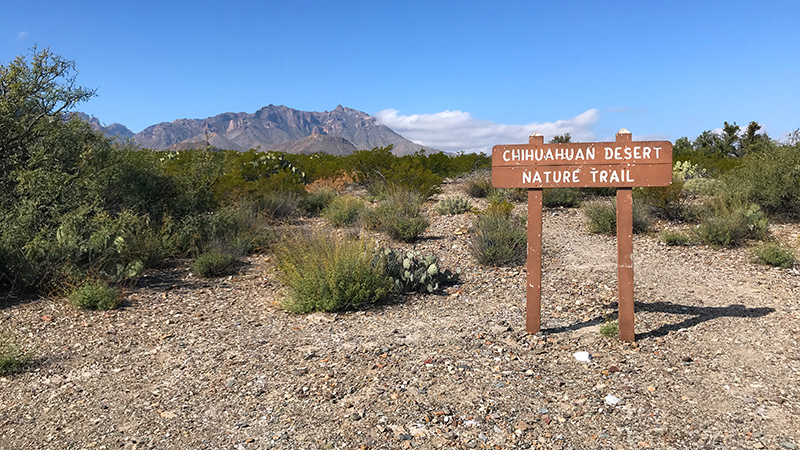
After visiting the Panther Junction Visitor Center and the Chisos Basin Visitor Center, and walking the Window View Trail, we were ready for some lunch and decided to check out the Dug Out Wells Picnic Area on our way to the Rio Grande Village Visitor Center.
Dug Out Wells is a historic desert oasis located 6.0 miles southeast of Panther Junction in Big Bend National Park. At this former ranch community site, you’ll find a picnic area with tables shaded by cottonwood trees and the half mile Chihuahuan Desert Nature Trail.
We were already halfway through our second and last day at Big Bend, so while we explored a bit of the trail, we ended up making a beeline for Rio Grande Village across the national park and had lunch at the Daniels Ranch Picnic Area instead.
Chihuahuan Desert Nature Trail
The Chihuahuan Desert Nature Trail is an easy, flat, 0.5 mile round trip, loop trail that passes remnants of human settlement and typical Chihuahuan Desert habitat.
The trail begins near the Dugout Wells Picnic Area loops into the dry desert and returns the lush area around the natural spring. With signs along the trail that describe the desert environment, it provides a great introduction to the Chihuahuan Desert ecosystem of Big Bend National Park.
The History Of Dug Out Wells
Tall cottonwoods in the desert are a sure indicator of running water. Here moisture seeps from a bed of gravel in the Chisos Mountains’ east flank. Around 1900, a settler dug out a spring to pool the seepage and later improved the flow with a windmill.
Settlers recognized the area’s value and built a ranching complex and small community with half a dozen buildings, and in 1911, the first schoolhouse in the region was built. The small frame schoolhouse also served as a meeting place for the local residents and inspired people of the area to call Dugout Wells a “cultural center of the Big Bend”.
In 1915, William James Green bought the land and ranched here with his family. Four of his daughters taught at the schoolhouse until it finally closed in 1933. Around 1937, the building itself was moved to San Vicente, a settlement located near the present day East side of the primitive River Road.
All that remains of the former ranching community is a single windmill, a picnic area, and a short nature trail. As you enter the shady grove, you will experience an instant change in climate and the relatively dense vegetation makes it an oasis for wildlife and a great spot for birdwatching.
Know Before You Go
About the Dug Out Wells Picnic Area:
- The Dug Out Wells Picnic Area is located between the Panther Junction Visitor Center and Rio Grande Village Visitor Center in Big Bend National Park.
- The Chihuahuan Desert Nature Trail, an easy 0.5 mile loop trail, leaves from the picnic area.
- Vault toilets are available.
About Big Bend National Park:
- Big Bend National Park is located in Brewster County, southwest Texas.
- The name Big Bend refers to the great U-turn the Rio Grande makes in Southwest Texas. The Rio Grande defines the park’s southern boundary for 118 miles.
- Park entrances are open 24 hours daily, all year. Entrance stations have variable seasons/hours.
- Admission fees are valid for seven days and are $30/vehicle, $25/motorcycle, $15/individual/bicyclist/pedestrian.
- There are five Visitor Centers in Big Bend National Park: Panther Junction, Chisos Basin, Castolon, Persimmon Gap, and Rio Grande Village.
- Download the Big Bend National Park maps.
- There are three developed campgrounds in the park: the Chisos Basin, Rio Grande Village, and Cottonwood campgrounds. Sites are first come, first-served, although a limited number of campsites in Rio Grande Village and the Chisos Basin campgrounds are reservable.
- Convenience stores are available and open year-round at Rio Grande Village, the Chisos Basin, and in the historic La Harmonia store at Castolon.
- Gas stations are located at Panther Junction and Rio Grande Village, and outside the park in Study Butte and Stillwell’s Ranch. Diesel is available at Panther Junction and in Study Butte.
- Pets are not allowed on trails, off roads, or on the river. Your pet can only go where your car can go and must be on a leash no longer than six feet in length or in a cage at all times. Pet etiquette and park regulations require that you always clean up after your pet and dispose of waste in trash receptacles.




